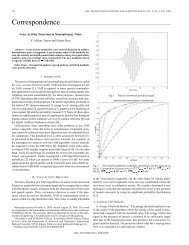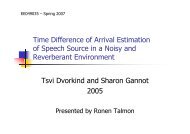Time - space compression in cyberspace art - Signal & Image ...
Time - space compression in cyberspace art - Signal & Image ...
Time - space compression in cyberspace art - Signal & Image ...
You also want an ePaper? Increase the reach of your titles
YUMPU automatically turns print PDFs into web optimized ePapers that Google loves.
Eduardo Kac, Genesis, 1998-99.<br />
From: http://www.ekac.org/gen<strong>in</strong>fo2.html<br />
The gene conta<strong>in</strong>ed a Morse-encoded verse from the biblical Book of Genesis. The<br />
verse reads: “Let man have dom<strong>in</strong>ion over the fish of the sea, and over the fowl of the air, and<br />
over every liv<strong>in</strong>g th<strong>in</strong>g that moves upon the e<strong>art</strong>h.” This verse implies humanity‟s dom<strong>in</strong>ation<br />
over nature. Morse code represents the dawn of the <strong>in</strong>formation age – the genesis of global<br />
time-<strong>space</strong> <strong>compression</strong>. The Genesis gene was <strong>in</strong>corporated <strong>in</strong>to bacteria, which were shown<br />
<strong>in</strong> the gallery. Web surfers could control ultraviolet illum<strong>in</strong>ation <strong>in</strong> the gallery, caus<strong>in</strong>g<br />
biological mutations <strong>in</strong> the bacteria conta<strong>in</strong><strong>in</strong>g the verse from Genesis. After successive<br />
manipulations, the DNA was decoded <strong>in</strong>to Morse code, and <strong>in</strong>to mutated verse <strong>in</strong> English.<br />
This <strong>art</strong> piece suggests a new holistic <strong>in</strong>teractive data sphere where the ability to change the<br />
verse is a reciprocal symbolic gesture.<br />
Cyber<strong>space</strong> signals Roland B<strong>art</strong>hes‟ “death of the author”, the disappearance of God<br />
and his hypostases – reason, science and law – while we witness a fuzzy-logic determ<strong>in</strong>ation<br />
<strong>in</strong> holistic, time-<strong>space</strong> compressed cyber<strong>space</strong>. Mean<strong>in</strong>g and knowledge are not constant<br />
<strong>in</strong>herited values; rather, they ga<strong>in</strong> a new “durée” of mean<strong>in</strong>g while we are immersed <strong>in</strong> realtime<br />
<strong>in</strong> the data hyper-sphere.<br />
The cyber<strong>space</strong> data sphere is an extended dimension (hyperbolic) of the global<br />
geography and the physical body, experienced by the surfer, the cyber-flâneur. The computer<br />
is a suitable metaphoric vehicle for consum<strong>in</strong>g electronically compressed cyber time-<strong>space</strong>.<br />
The cyber-flâneur passes through compressed data <strong>space</strong>-time populated with avatars and<br />
virtual objects. As Charles Baudelaire‟s 19th century flâneur was a product of<br />
<strong>in</strong>dustrialization and modernity, a spectator of modern life <strong>in</strong> the ris<strong>in</strong>g urban sprawl, he is an<br />
upgraded product of New Media: the cyber-flâneur, an avatar-spectator of virtual data<br />
structures. He is an entity whose aim is to disappear <strong>in</strong> the time <strong>space</strong> of the digital city – a<br />
viewer who is everywhere and nowhere (a superposition state) <strong>in</strong> possession of his<br />
anonymity. He is the one who experiences the fuzzy ontology of cyber<strong>space</strong> (the cyber-aura),<br />
an immediate time <strong>space</strong> where, as Paul Virilio argued, „the moment of dep<strong>art</strong>ure is<br />
compressed to that of arrival”. The flâneur‟s “durée” is an impression of endless movement<br />
captured by pass<strong>in</strong>g through the social <strong>space</strong> of modernity, and projected on his m<strong>in</strong>d. Super-















